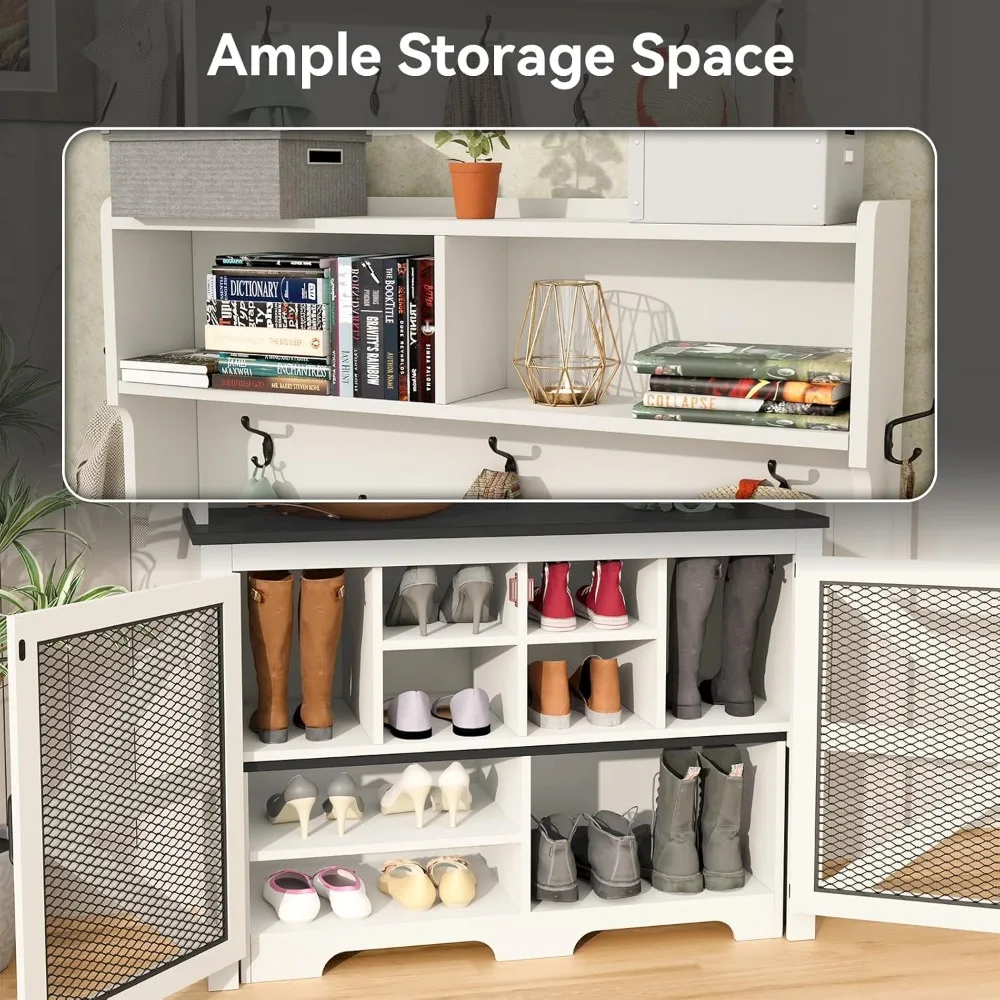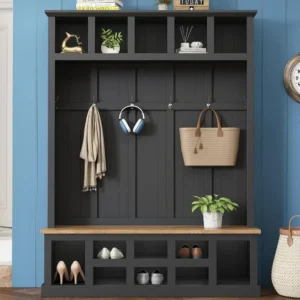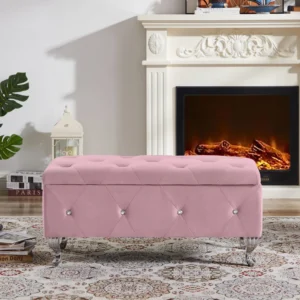Understanding the Challenges of Small Entryways
The entryway is one of the busiest spots in any home, yet it’s often the smallest. This combination creates unique challenges that many homeowners struggle with daily. Small entryways typically face several limitations:
- Limited square footage (often just 15-30 square feet in modern homes)
- High traffic as family members and guests enter and exit
- Multiple functions required in one compact space
- Seasonal item storage needs that constantly change
The pain points of small entryways are particularly frustrating because they affect your daily routine. Shoes pile up, coats get draped over furniture, keys go missing, and mail collects in unorganized stacks. The result is not just visual clutter, but also stress and inefficiency as you start and end your day.
A well-organized entryway isn’t just about appearances—though first impressions matter. It’s about creating a functional transition space that supports your lifestyle. The good news is that even the smallest entrance can be transformed with smart space-saving benches for entryways and thoughtful organization strategies. With some planning, your entryway can become a space that works efficiently while still welcoming visitors with style.
When approaching the challenge of organizing a small entryway, understanding these fundamental constraints will help you select solutions that truly work for your specific space and needs.
Maximizing Vertical Space: Wall Solutions That Work
When floor space is limited, looking upward unlocks tremendous storage potential. Wall-mounted solutions let you take advantage of vertical space that’s often overlooked in small entryways:
Wall-mounted hook systems: Install hooks at different heights (about 48 inches/122 cm for adults and 36 inches/91 cm for children) to accommodate everyone in the household. Look for stylish options that add visual interest while holding coats, bags, and hats.
Rail systems with movable components: These versatile systems let you customize the configuration with hooks, small shelves, and bins that can be rearranged as needs change.
Floating shelves: Install shelves 6-8 inches (15-20 cm) deep above hooks to store items like hats, gloves, and decorative elements. The visual clearance below keeps the space feeling open.
Mail organizers and key stations: Mount these directly on the wall near the door at about eye level (5-6 feet/152-183 cm high) to catch important items before they contribute to counter clutter.
Vertical shoe racks: Wall-mounted shoe organizers can hold 4-8 pairs while using zero floor space. Look for styles with angled shelves that display shoes while keeping them secure.
When installing any wall-mounted solution, be mindful of weight limits for your wall type. Most drywall can safely hold 10-25 pounds per anchor, depending on the hardware used.
The beauty of vertical solutions is that they work even in extremely narrow spaces. Even a hallway just 30 inches (76 cm) wide can accommodate slim wall-mounted storage that keeps essentials organized without impeding traffic flow. For comprehensive space-saving entryway seating solutions that work alongside vertical storage, consider options that tuck neatly against walls when not in use.
Many homeowners find that entryway hall trees offer an excellent all-in-one vertical storage solution, combining hooks, shelves, and sometimes bench seating in a single unit designed specifically for entryway dimensions.
Multi-Functional Furniture: The Secret to Entryway Success
In small spaces, every piece of furniture should perform multiple duties. This principle is especially important in entryways, where space is at a premium but functionality can’t be compromised:
Storage benches: Perhaps the ultimate multi-tasker, a storage bench provides seating for putting on shoes, hidden storage for seasonal items, and a decorative element that anchors the space. Look for options 30-40 inches (76-102 cm) wide that won’t overwhelm small areas.
Slim console tables: Tables just 10-12 inches (25-30 cm) deep can fit in narrow hallways while providing a surface for keys, mail, and decorative elements. Choose options with drawers or shelves underneath to maximize storage capacity.
Narrow cabinets: Specially designed entryway cabinets can be as slim as 8-10 inches (20-25 cm) deep while providing concealed storage for shoes, accessories, and other small items.
Corner-fitting furniture: Don’t overlook awkward corners! Corner benches and shelving units transform these difficult spaces into functional storage areas without blocking traffic flow.
Nesting furniture: Items that can be tucked away when not in use (like small stools that slide under a bench) provide flexibility without permanent footprint expansion.
When selecting multi-functional pieces, carefully measure your available space and think about clearance needs. Doors should be able to open fully, and pathways should maintain at least 30-36 inches (76-91 cm) of walking space.

The best small benches for entryways combine comfortable seating with practical storage solutions. For extremely tight spaces, consider narrow entryway benches specifically designed to fit in limited floor plans while still providing essential functionality.
Shoe Storage Solutions: Conquering the Footwear Challenge
Shoes are often the biggest source of entryway clutter. Without proper storage, they quickly accumulate, creating both visual chaos and tripping hazards. Here are effective solutions for taming footwear disorder:
Vertical shoe cabinets: These slim cabinets (often just 6-8 inches/15-20 cm deep) use tilting compartments that allow shoes to be stored heel-to-toe, maximizing capacity in minimal space. Some models can hold 12-20 pairs while taking up minimal floor space.
Under-bench storage: Many entryway benches include lower shelves or cubbies specifically designed for shoe storage, keeping footwear accessible but visually contained.
Over-door organizers: For entryways with closets, over-door shoe pockets can store 12-24 pairs without using precious floor or shelf space inside the closet.
Wall-mounted racks: These keep shoes off the floor completely and can be installed at various heights to accommodate different family members.
Hidden solutions: Consider furniture pieces with drop-down fronts that conceal shoes while still keeping them accessible.
| Solution Type | Capacity (pairs) | Footprint (sq ft) | Price Range |
|---|---|---|---|
| Vertical Cabinet | 12-20 | 2-3 | $$$-$$$$ |
| Storage Bench | 6-12 | 3-4 | $$-$$$$ |
| Over-Door Rack | 12-24 | 0 | $-$$ |
| Wall-Mounted | 4-8 | 0 | $-$$$ |
| Hidden Drawers | 3-6 | 2-3 | $$$-$$$$ |
A practical approach for many households is seasonal rotation. Store off-season footwear elsewhere to minimize the number of shoes needed in the entryway at any given time. The ultimate guide to organizing shoes in your entryway provides comprehensive strategies for managing this common challenge.
For a complete solution, consider a shoe storage bench designed for entryways that combines comfortable seating with dedicated shoe organization features.
Clever Door and Behind-Door Storage Ideas
Doors themselves—and the spaces around them—offer valuable yet frequently overlooked storage opportunities:
Over-door organizers: Beyond shoe storage, over-door solutions can include hooks, pockets, or shelves for accessories, small electronics, pet supplies, and more. Be mindful of weight limitations (typically 10-20 pounds/4.5-9 kg maximum) to prevent door damage.
Behind-door hook systems: The space behind a door that opens against a wall can accommodate slim hook rails for coats, bags, or frequently used items. These stay hidden when the door is open but provide accessible storage.
Maximizing door swing space: When planning your entryway organization, remember to account for the arc of the door swing. This space can’t contain furniture but might accommodate wall-mounted storage above doorknob height.
Door-mounted mirrors with storage: Mirrors that open like medicine cabinets provide hidden storage while also making the space feel larger and serving the practical purpose of last-minute appearance checks.
Closet door optimization: If your entryway includes a closet, don’t waste the door surface. Add hooks, racks, or pocket organizers to both sides for maximum efficiency.
When implementing door storage solutions, ensure they don’t interfere with the door’s operation or create noise when opening and closing. Use felt pads or bumpers where needed to prevent rattling or wall damage.
For entryways with challenging layouts, corner entryway benches can work well with door configurations by utilizing spaces that might otherwise remain empty.
Lighting and Visual Tricks to Make Entryways Feel Larger
Strategic design choices can make even the smallest entryway feel more spacious and welcoming:
Mirror placement: Position mirrors to reflect light and create the illusion of depth. A mirror placed opposite a window or light source maximizes brightness. Full-length mirrors can visually double the perceived size of narrow entryways.
Lighting solutions: Avoid dark corners that make spaces feel smaller. Consider:
- Recessed ceiling lights that don’t take up visual space
- Wall sconces at eye level to create a sense of width
LED strip lighting under shelves or benches for both function and ambiance
Color strategy: Light colors generally make spaces feel larger, but don’t be afraid of an accent wall in a deeper hue to create depth. For cohesive flow, use colors that complement adjacent rooms.
Visual continuity: Use the same flooring material from the entryway into connecting spaces to create an uninterrupted visual flow that makes the entry feel like part of a larger area.
Minimal décor: Be selective with decorative elements. A few meaningful pieces make more impact than numerous small items that create visual clutter.
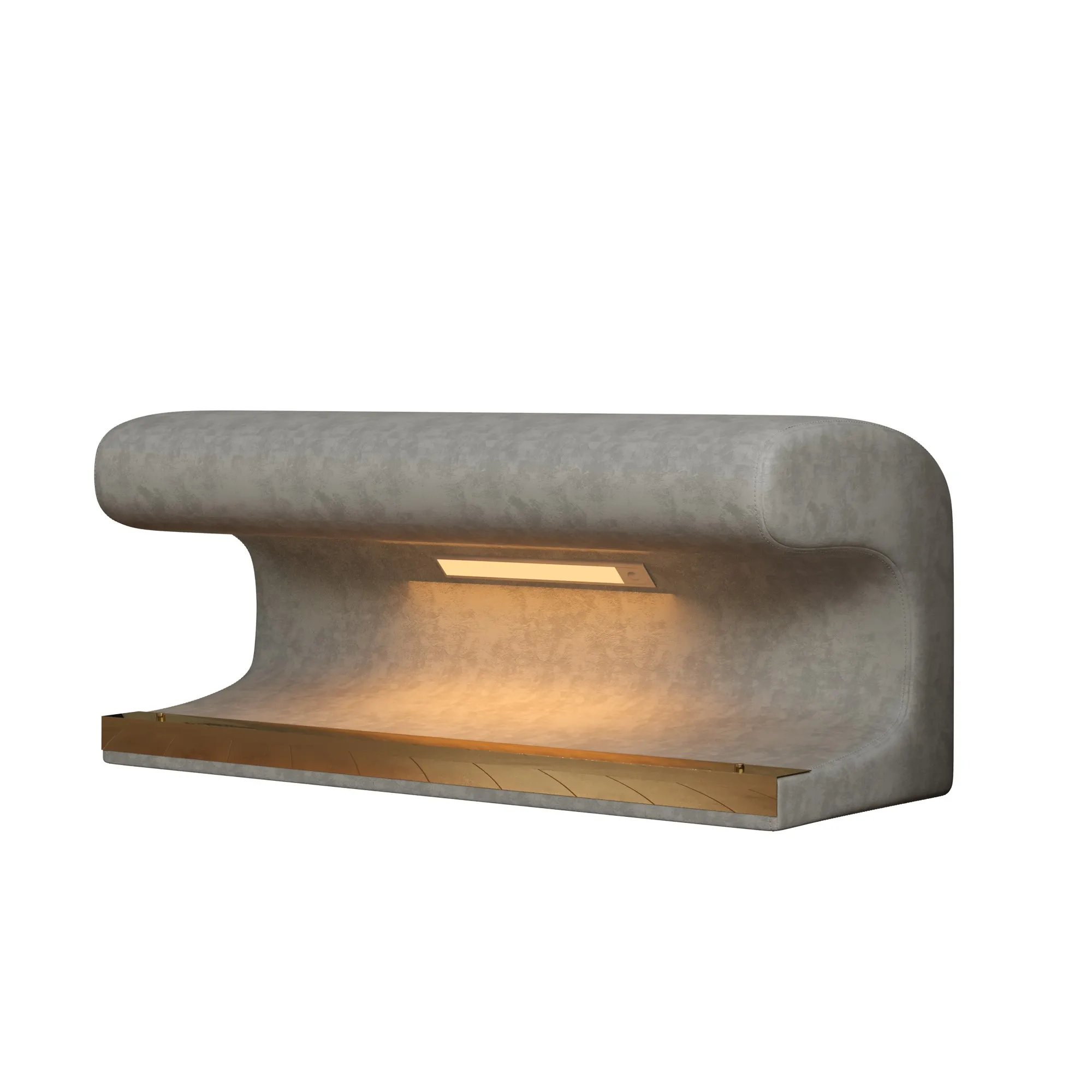
Smart lighting choices can dramatically transform how spacious an entry feels. Under-bench lighting, in particular, creates the illusion that furniture is floating, making the floor area appear larger. For more ideas on creating a visually appealing entrance, explore our small modern entryway styling tips that combine aesthetics with practicality.
Decluttering Strategies: The Foundation of Entryway Organization
Even the most innovative storage solutions will fail without consistent decluttering habits. Creating and maintaining an organized entryway requires thoughtful systems:
- Entryway inventory audit: Determine what truly belongs in your entry space. Typically, this includes:
- Everyday outerwear (limit to current season)
- Frequently used shoes (2-3 pairs per person)
- Keys, wallets, phones, and essential grab-and-go items
Weather gear like umbrellas or sunscreen
Tiered storage system: Create zones based on usage frequency:
- Daily items: Easily accessible at grab height
- Weekly items: Secondary storage areas
Seasonal items: Rotated in and out as needed
One in, one out rule: For items like coats and shoes, remove one existing item when adding something new to prevent gradual accumulation.
Daily reset routine: Establish a quick 5-minute end-of-day practice to return items to their proper places:
1. Return scattered shoes to designated storage
2. Hang up coats and bags
3. Sort mail and papers
4. Return borrowed items to their proper rooms
5. Wipe down high-touch surfacesFamily cooperation: Assign hooks, bins, or shelves to each family member and ensure everyone understands the system. Consider lower-height solutions for children to encourage independence.
The foundation of successful organizing narrow entryway spaces is establishing clear boundaries about what belongs there and what doesn’t. Be ruthless about relocating items that have better homes elsewhere in your house.
Custom Solutions for Specific Entryway Challenges
Every entryway presents unique challenges based on architectural constraints and household needs. Here are solutions for some common specific situations:
- No-closet entryways: When there’s no built-in storage, create your own:
- Install a freestanding wardrobe just 12-15 inches (30-38 cm) deep
- Create a “closet wall” with hooks, shelves, and benches in a coordinated design
Use room dividers with built-in storage to create a dedicated entry zone in open-plan homes
Extremely narrow hallway entrances: For hallways under 36 inches (91 cm) wide:
- Use wall-mounted solutions exclusively to preserve walking space
- Install shallow floating shelves (6 inches/15 cm or less in depth)
Consider ceiling hooks for rarely-used seasonal items
Apartment entry solutions: Renter-friendly options that require minimal modification:
- Tension rod systems that install without drilling
- Freestanding storage furniture that can move with you
Command hooks and removable adhesive solutions
Shared entryway organization: For multi-family dwellings:
- Color-code or label storage areas for each household
- Use concealed storage to reduce visual chaos
Establish clear boundaries and maintenance responsibilities
Accessibility considerations: Design for all users:
- Install hooks and storage at various heights
- Ensure pathways remain at least 36 inches (91 cm) wide
- Choose easy-open drawers and containers that don’t require complex manipulation
Coat Rack Shoe Bench, Corner Entryway Bench, Corner Hall Tree, Shoe Bench for Entryway
$313.58 Select options This product has multiple variants. The options may be chosen on the product pageShoe Storage Bench for Entryway
$459.02 Select options This product has multiple variants. The options may be chosen on the product pageCorner Entryway Bench, Entryway Bench with Cushion, Modern Entryway Bench, Shoe Bench for Entryway
$476.34 Select options This product has multiple variants. The options may be chosen on the product pageBench with Hooks and Storage, Entryway Hall Tree, Mudroom Bench with Cubbies, Mudroom Bench with Shoe Storage
$818.38 Select options This product has multiple variants. The options may be chosen on the product pageEntryway Coat Rack Bench, Entryway Hall Tree, Farmhouse Mudroom Bench, Mudroom Bench with Shoe Storage
$805.09 Select options This product has multiple variants. The options may be chosen on the product pageEntryway Bench with Cushion, Small Entryway Bench
$466.79 Select options This product has multiple variants. The options may be chosen on the product page
For awkward corner spaces that are often wasted, corner hall trees provide efficient storage solutions that transform these challenging areas into functional organization zones.
DIY Projects to Maximize Entryway Space
Creating custom solutions can address your unique space constraints while expressing personal style. These DIY projects require minimal tools and moderate skills:
Wall-mounted shelf with integrated hooks: Combine a floating shelf (24-36 inches/61-91 cm wide) with decorative hooks mounted underneath. Materials cost: $30-50; Time: 2-3 hours.
Custom-sized storage bench: Build a bench tailored to your exact space measurements using plywood, lumber, and basic tools. Add hinges for a lift-top storage compartment. Materials cost: $75-150; Time: Weekend project.
Repurposed furniture transformations:
- Convert an old dresser into an entryway console by adding a fresh coat of paint and new hardware
- Transform a bookshelf into cubby storage with baskets
Repurpose vintage suitcases as decorative storage boxes
Weekend entryway command center: Create a mail sorter, key station, and message board using cork, chalkboard paint, and small containers. Materials cost: $40-60; Time: 4-5 hours.
Budget-conscious solutions:
- Use tension rods between walls to create adjustable hanging space
- Repurpose kitchen or office organizers for entryway use
- Create custom bins from cardboard boxes covered with decorative paper or fabric
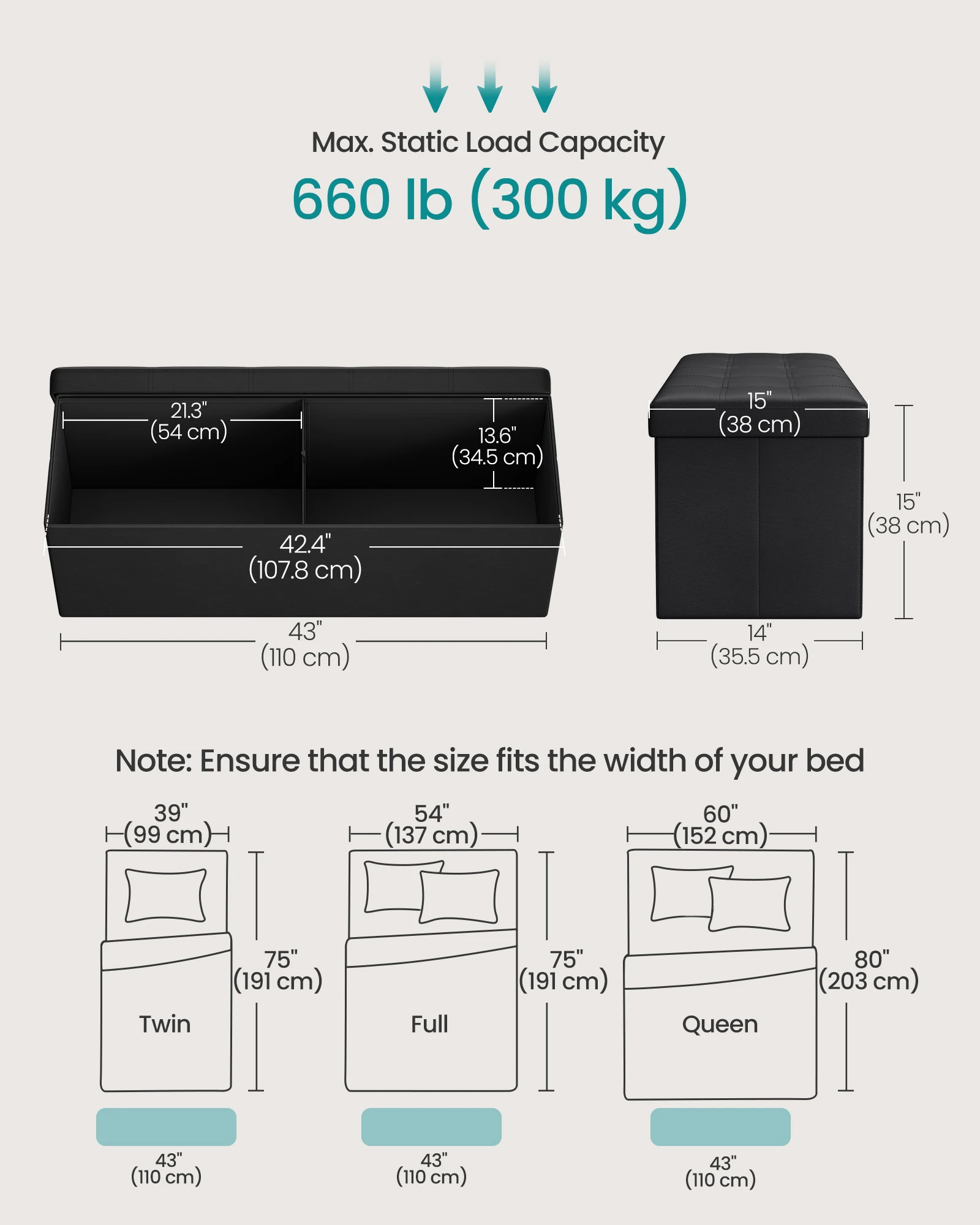
For smaller spaces, smart entryway benches that incorporate multiple functions can be customized to fit unusual dimensions or serve specific household needs.
Is Your Entryway Working? Evaluation and Maintenance Tips
Even the best-designed organization system needs periodic assessment and adjustment:
- Signs your system needs tweaking:
- Items consistently left on the floor instead of put away
- Certain storage areas overflowing while others remain empty
- Family members avoiding using the designated systems
Seasonal transitions creating temporary chaos
Seasonal reassessment checklist:
1. Evaluate if current storage meets the season’s needs
2. Rotate seasonal items (bring winter gear forward in fall, store it away in spring)
3. Check if hooks, shelves, and containers remain securely mounted
4. Assess if the system still serves your household’s changing needs
Regular maintenance prevents small issues from becoming major organizational breakdowns. Be willing to adjust your system rather than forcing habits that aren’t working for your household.
Frequently Asked Questions About Entryway Storage
How can I store bulky winter items in a tiny entryway?
Implement a seasonal rotation system. Store off-season items elsewhere, and use compression bags for puffy coats and accessories. Consider over-door hanging organizers for hats and gloves, and use umbrella stands that tuck into corners.
What solutions work for entryways with no wall space?
Look to freestanding furniture like slim hall trees or room dividers with built-in storage. Door-mounted options can also provide significant storage without requiring wall space. Consider floor-to-ceiling tension rod systems that create vertical storage between floor and ceiling.
How can I organize my entryway without damaging rental property walls?
Use tension rods, command hooks, and freestanding furniture. Over-door organizers require no installation. Consider furniture anchored between floor and ceiling with pressure mounts rather than wall attachments. Removable wallpaper can add style without permanent changes.
What’s the best way to manage entryway clutter with children and pets?
Install hooks and bins at child height to encourage independence. Create a dedicated “pet station” with hooks for leashes and bins for toys. Implement daily reset routines with the whole family, and use machine-washable rugs and durable materials that can withstand heavy use.
How can smart home technology improve entryway organization?
Motion-activated lighting eliminates fumbling for switches. Smart locks reduce the need for key storage. Voice-controlled assistants can help track items (“Alexa, remember my umbrella is in the side closet”). For smaller entryways, small entryway benches with integrated charging stations keep devices organized and ready.
By implementing these space-saving strategies from Nested Goods, even the smallest entryway can become an organized, functional, and welcoming introduction to your home. Remember that the perfect system balances efficiency with your household’s unique needs and aesthetic preferences.

